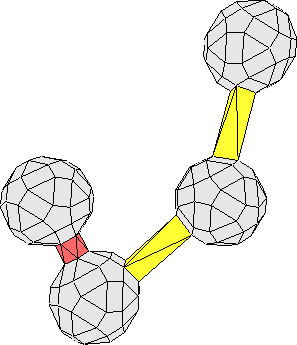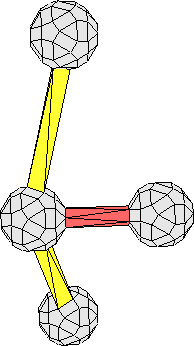Christopher J. Kimmer, Ph.D.
IU Southeast Informatics
iSci
the informatics of scientific computing
Clusters of Too-close Vertices
The method for constructing a tiling by Equation
3.9
worked only because every
operation of
![]() (except the first two) was followed by
(except the first two) was followed by
![]() .
If
.
If
![]() is omitted, no points are ever eliminated
and the fractal AD alluded to in Section 3.3 is constructed. The growth
of a vertex set without pruning can be written as
is omitted, no points are ever eliminated
and the fractal AD alluded to in Section 3.3 is constructed. The growth
of a vertex set without pruning can be written as
The too-short edges that are never prumed in
As
![]() is successively applied to a starting vertex
x
0
,
the action of
is successively applied to a starting vertex
x
0
,
the action of
![]() continues to introduces
too-short separations along 3- and 5-fold directions. The AD of this tiling
is bounded, so it is clear that there will still be a shortest
separation between
points in the tiling, and in fact, no shorter separations than the
too-short 3- or 5-fold edges are introduced by omitting
continues to introduces
too-short separations along 3- and 5-fold directions. The AD of this tiling
is bounded, so it is clear that there will still be a shortest
separation between
points in the tiling, and in fact, no shorter separations than the
too-short 3- or 5-fold edges are introduced by omitting
![]() .
The local environments of
vertices that are separated from other vertices by too-short separations can
be divided into a few categories. The simplest configuration is
when two vertices are joined by a single too-short edge, either along
a 5-fold or 3-fold direction. Also appearing are groups of three vertices
where one vertex
is joined simultaneously to two others along too-short edges, either
two 3-fold edges or one 3- and one 5-fold edge.
Finally, there are groups of four vertices with a pair of
too-short edges. In one case, one vertex is
joined along both too-short 5- and 3-fold directions to two other vertices;
in another case, a vertex is joined along two different
too-short 3-fold edges (Figure
3.5
).
Finally, there are groups of four vertices joined by
two too-short 3-fold edges and one too-short 5-fold edge
(Figure
3.6
).
.
The local environments of
vertices that are separated from other vertices by too-short separations can
be divided into a few categories. The simplest configuration is
when two vertices are joined by a single too-short edge, either along
a 5-fold or 3-fold direction. Also appearing are groups of three vertices
where one vertex
is joined simultaneously to two others along too-short edges, either
two 3-fold edges or one 3- and one 5-fold edge.
Finally, there are groups of four vertices with a pair of
too-short edges. In one case, one vertex is
joined along both too-short 5- and 3-fold directions to two other vertices;
in another case, a vertex is joined along two different
too-short 3-fold edges (Figure
3.5
).
Finally, there are groups of four vertices joined by
two too-short 3-fold edges and one too-short 5-fold edge
(Figure
3.6
).

|

|
In order to return to a tiling by the original tiles, more than a simple pruning operation where members of pairs are deleted is necessary since the configurations of too-close vertices are sometimes more complicated than simple pairs. For the triplets of vertices, either the one vertex with two too-short edges must be chosen, or the other vertices must be kept. Each of the two quadruplets of vertices must be treated differently.
The configuration shown in Figure
3.5
results from
the application of
![]() to a starting patch that is congruent to
the
τ
-deflation of the large tile face containing long and short
3-fold edges, and this configuration arises whenever a too-short 3-fold
edge has not been pruned. There are four possible ways reduce this
configuration to one that
to a starting patch that is congruent to
the
τ
-deflation of the large tile face containing long and short
3-fold edges, and this configuration arises whenever a too-short 3-fold
edge has not been pruned. There are four possible ways reduce this
configuration to one that
![]() will be able to tile. Keeping a
vertex with two too-short edges will uniquely determine the
configuration while keeping a vertex with only one too-short edges forces
a choice to be made between the two remaining vertices. All four of these
choices lead to vertex configurations that arise in tilings constructed
by inflation rules.
will be able to tile. Keeping a
vertex with two too-short edges will uniquely determine the
configuration while keeping a vertex with only one too-short edges forces
a choice to be made between the two remaining vertices. All four of these
choices lead to vertex configurations that arise in tilings constructed
by inflation rules.
The quartet of vertices shown in Figure
3.6
arises
from the application of
![]() to the preceding paragraph's
configuration. Examination of Figure
3.6
shows that the only
free choice to be made in order to eliminate too-short separations occurs along
the short 5-fold edge.
to the preceding paragraph's
configuration. Examination of Figure
3.6
shows that the only
free choice to be made in order to eliminate too-short separations occurs along
the short 5-fold edge.
Chris Kimmer 2011-06-01